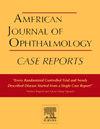Pseudophakic angle-closure 14 Years after cataract surgery: a case report and systematic review of the literature
Q3 Medicine
引用次数: 0
Abstract
Purpose
Pseudophakic secondary angle closure is an uncommon event, especially when it manifests itself many years after uneventful cataract surgery. We report a case of a patient who presented with a sudden increase in intraocular pressure (IOP) several years after surgery, highlighting the diagnostic challenges associated. We performed a systematic review of potential etiologies, including spontaneous aqueous misdirection and capsular block syndrome (CBS).
Observation
A 91-year-old Caucasian male presented with sudden visual acuity reduction to counting fingers at 30 cm in the left eye (LE), his only seeing eye. Fourteen years earlier, the patient had undergone uncomplicated phacoemulsification with intraocular lens implantation. The slit-lamp examination showed corneal edema and a shallow anterior chamber. IOP measured by Goldmann applanation tonometry was 55 mmHg. Gonioscopy was not feasible, and the anatomical features were at presentation were not univocal for a specific diagnosis, though they were highly suggestive of late-onset CBS with pupillary block or spontaneous aqueous misdirection. The patient underwent laser peripheral iridotomy in the LE, which proved ineffective. Despite the absence of recent surgical interventions and the presence of a markedly elongated axial length of 32 mm, the patient was treated for aqueous misdirection, undergoing pars plana vitrectomy combined with irido-zonulo-hyaloid-vitrectomy. At the last follow-up visit, 4 months postoperatively, the patient's condition significantly improved. Best-corrected visual acuity in the LE improved to 20/40, and the IOP was well-controlled at 10 mmHg. A systematic literature review identified 24 cases of spontaneous aqueous misdirection and 2 cases of late-onset CBS with IOP elevation (5 when early onset was considered).
Conclusion and importance
This case underscores the significant challenges in establishing an accurate diagnosis in cases of secondary angle closure in pseudophakic patients, particularly when presentation occurs many years after uncomplicated cataract surgery. The overlap of clinical features among rare entities, such as aqueous misdirection and late-onset CBS, further complicates the diagnostic process. Prompt recognition and timely intervention remain essential to prevent the potentially severe consequences of the condition.
白内障术后14年假晶状体闭角一例报告及文献系统复习
目的白内障继发性闭角是一种罕见的事件,尤其是在白内障手术多年后再次发生。我们报告一例患者在手术后几年出现眼压(IOP)突然升高,突出了相关的诊断挑战。我们对潜在的病因进行了系统的回顾,包括自发性水误导和荚膜阻塞综合征(CBS)。1例91岁白人男性,因唯一能看见的左眼(LE)视力突然下降至30 cm处数指。14年前,患者接受了无并发症的超声乳化术和人工晶状体植入术。裂隙灯检查显示角膜水肿和浅前房。Goldmann眼压计眼压为55 mmHg。角膜镜检查是不可行的,并且解剖特征在表现时并不是单一的特定诊断,尽管它们高度提示晚发性CBS伴瞳孔阻滞或自发性水误导。患者在LE行激光周围虹膜切开术,结果无效。尽管最近没有手术干预,且存在明显延长的32 mm轴向长度,但患者接受了水误导治疗,接受了平面部玻璃体切除术联合虹膜带-玻璃体-玻璃体切除术。术后4个月末次随访,患者病情明显好转。LE的最佳矫正视力提高到20/40,IOP控制在10 mmHg。系统的文献回顾确定了24例自发性水性误导和2例伴IOP升高的晚发型CBS(考虑早发型时为5例)。结论和重要性:本病例强调了在假性晶状体患者继发性闭角病例中建立准确诊断的重大挑战,特别是在无并发症白内障手术多年后出现的病例。罕见的临床特征的重叠,如含水误导和迟发性CBS,进一步使诊断过程复杂化。及时认识和及时干预仍然是预防该病潜在严重后果的关键。
本文章由计算机程序翻译,如有差异,请以英文原文为准。
求助全文
约1分钟内获得全文
求助全文
来源期刊

American Journal of Ophthalmology Case Reports
Medicine-Ophthalmology
CiteScore
2.40
自引率
0.00%
发文量
513
审稿时长
16 weeks
期刊介绍:
The American Journal of Ophthalmology Case Reports is a peer-reviewed, scientific publication that welcomes the submission of original, previously unpublished case report manuscripts directed to ophthalmologists and visual science specialists. The cases shall be challenging and stimulating but shall also be presented in an educational format to engage the readers as if they are working alongside with the caring clinician scientists to manage the patients. Submissions shall be clear, concise, and well-documented reports. Brief reports and case series submissions on specific themes are also very welcome.
 求助内容:
求助内容: 应助结果提醒方式:
应助结果提醒方式:


